September 1st- Cuttyhunk Island, MA
Yesterday we shook the cobwebs out of Catalpa’s sails and headed out to Cuttyhunk for a few days of salty relaxation. It has been a month since our return to Dartmouth. We’ve, more or less, reaclimated to life on land. A portion of my mind is always at sea.
Most of the past month has been taken up with domestic duties. With the exception of a few maintenance issues, the house did well over the winter. No frozen pipes. There was (and still is) plenty of yard maintenance to be done. We are still evicting the mouse population that have taken up residence. This is a boat log so I will end my land stories there.
Catalpa has had some light maintenance and cleaning. After unloading a ton of gear (and an extra 35lb anchor) the waterline has risen and she seems a little quicker when sailing in light air. My much abused varnish has had some work done. The cockpit combing is looking much better. A few more coats will go on in the future. The dinghy has had some fiberglass repairs and 4 coats of white marine paint on the exterior. It’s looking very “Bristol”. While working on the dink we used our rowing dory that I built a few years ago.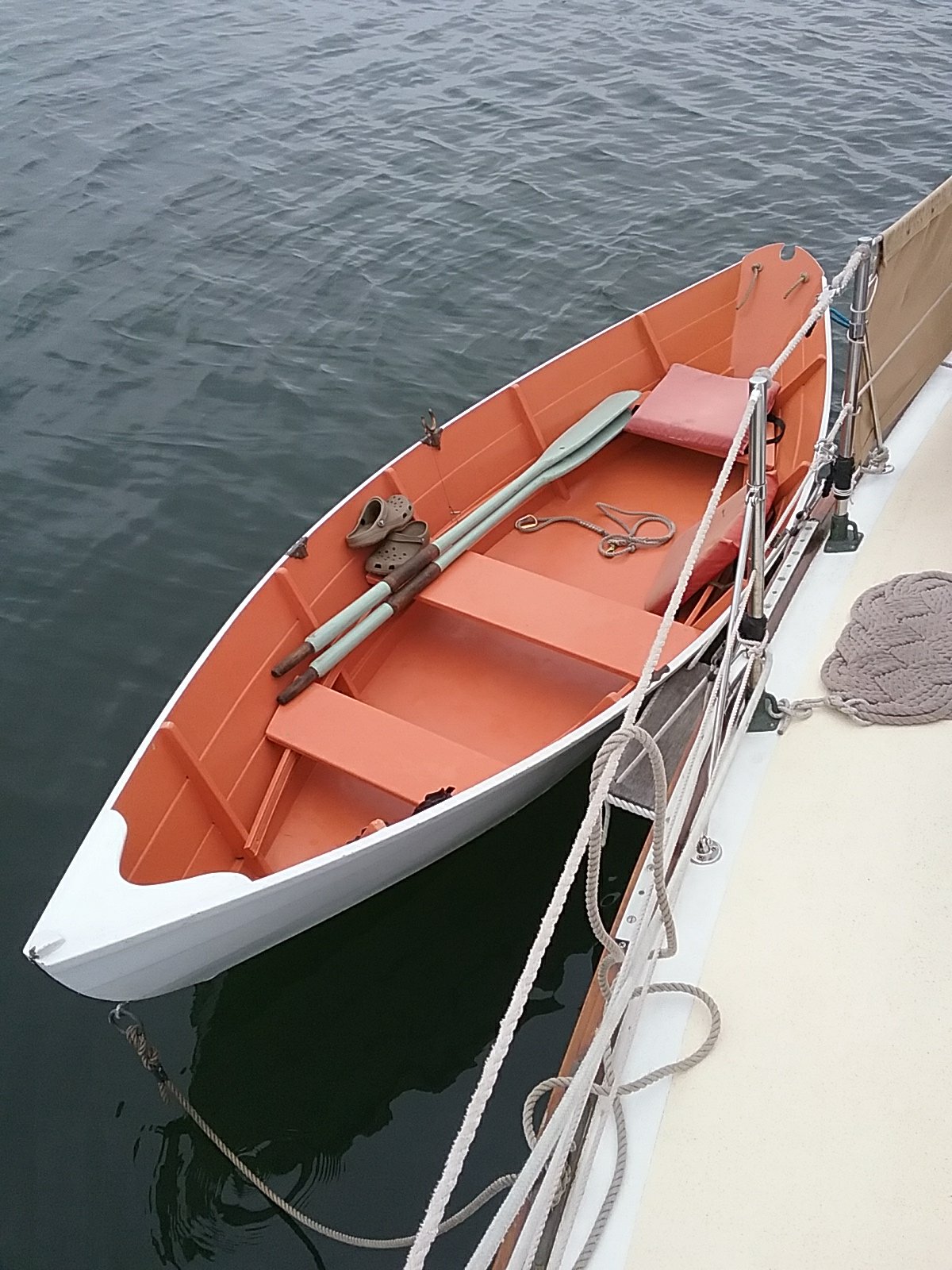
I wanted to do a recap on our trip South. I’ll include any information that seems relevant to a mariner along with some thoughts and observations.
The ICW mileage from Padanaram Harbor to Boot Key Harbor is roughly 1850 miles (1608 nm). Round trip that’s 3700 miles (3216 nm). We stopped at 64 different anchorages on our way south. 55 anchorages on our way north. This number is a little muddy as we sometimes anchored at multiple locations in the same harbor (4 or 5 places in Boot Key). I didn’t count those instances. We left on September 16th and returned on August 1st for a total of 321 days away from our home port. We grounded in the mud once (somewhat intentionally). We hit bottom a few other times but in all instances were able to continue on. We hit several logs and one 10′ 8×8 beam. The beam was the most memorable but none did any damage. I hit one aid to navigation in a moment of inattention. This is to be avoided. We mostly anchored or moored on the trip. We probably tied to a dock for a week or so. We spent around 5 1/2 months in Florida. 62 days in Vero Beach. 46 days in Marathon. Somewhere around 3 1/2 months were spent at those two locations. Marathon/ Boot Key Harbor was our furthest point south.
The trip north was MUCH easier than the trip south to Florida. The daylight hours are shorter in the fall. We kept to traveling during daylight with the exception of our NJ passage to Atlantic City. My days were spent piloting Catalpa. In the evening I was preoccupied with navigation. I often wasn’t sure about where our next stop was going to be. I’d run Ollie to shore, eat dinner, then look over the charts and guide books. Weather and currents predictions were also on the evening menu. I was often tired and needed a break after a few days. On the return trip I knew the good anchoring spots and sometimes found better harbors. I was able to spend more time paying attention to currents and weather routing. I was more organized and knew where to fuel up or get groceries. Experience is the best teacher.
Cruising with an active, young, dog takes a lot of dedication but we wouldn’t have it any other way. Oliver is very intelligent and was able to pick up skills easily. If I say, “Back to the boat!”. He runs to the dinghy and jumps in. It’s a great parlour trick if people are hanging around the docks. We got him to shore EVERY day. It was part of our navigation equation. The satellite view on Google maps was very helpful. We made sure to provide plenty of doggy activity in the appropriate places. He mostly slept during the day while we were sailing. He will “eliminate” on deck if he has to but avoids it. We’ve had him on the boat since he was a pup so he knows the drill. People ask about dog hair. I say, “don’t ask”. Getting good dog food was a bit of a problem in the south. We feed him a specific brand (Orijen) and supplement it with a dehydrated food (Honest Kitchen). I either mail ordered his bags of dry food or I’d buy 80lbs if we found it in a pet shop. The dehydrated food lasted until Vero Beach and we were able to buy more there. He made many friends along the way (as did we).
Our Beta Marine diesel engine was indispensable and ran flawlessly. We had around 200 hours on the engine before departure. We now have over 1000. A reliable source of propulsion is important for a trip down the Intracoastal. We broke two water pump impellers in the first few months but none after. I suspect they were defective. The Beta is a Japanese tractor engine (Kabota) which is then converted to a marine engine by an English company (Beta). I like to think it has some international flair. Since neither GB nor the US can stomach the metric system, it is necessary to carry both imperial and metric wrenches. Other than carrying two sets of wrenches, the engineers at Beta made it easy to service. I have to do an oil change every 150 hours and they made it as enjoyable as an oil change can possibly be. On the other hand, Carl Alberg (Catalpa’s designer) didn’t make engine access a priority. Getting at the transmission is torture but I’ve become used to it.
September 2nd- Cuttyhunk Island, MA
Rain.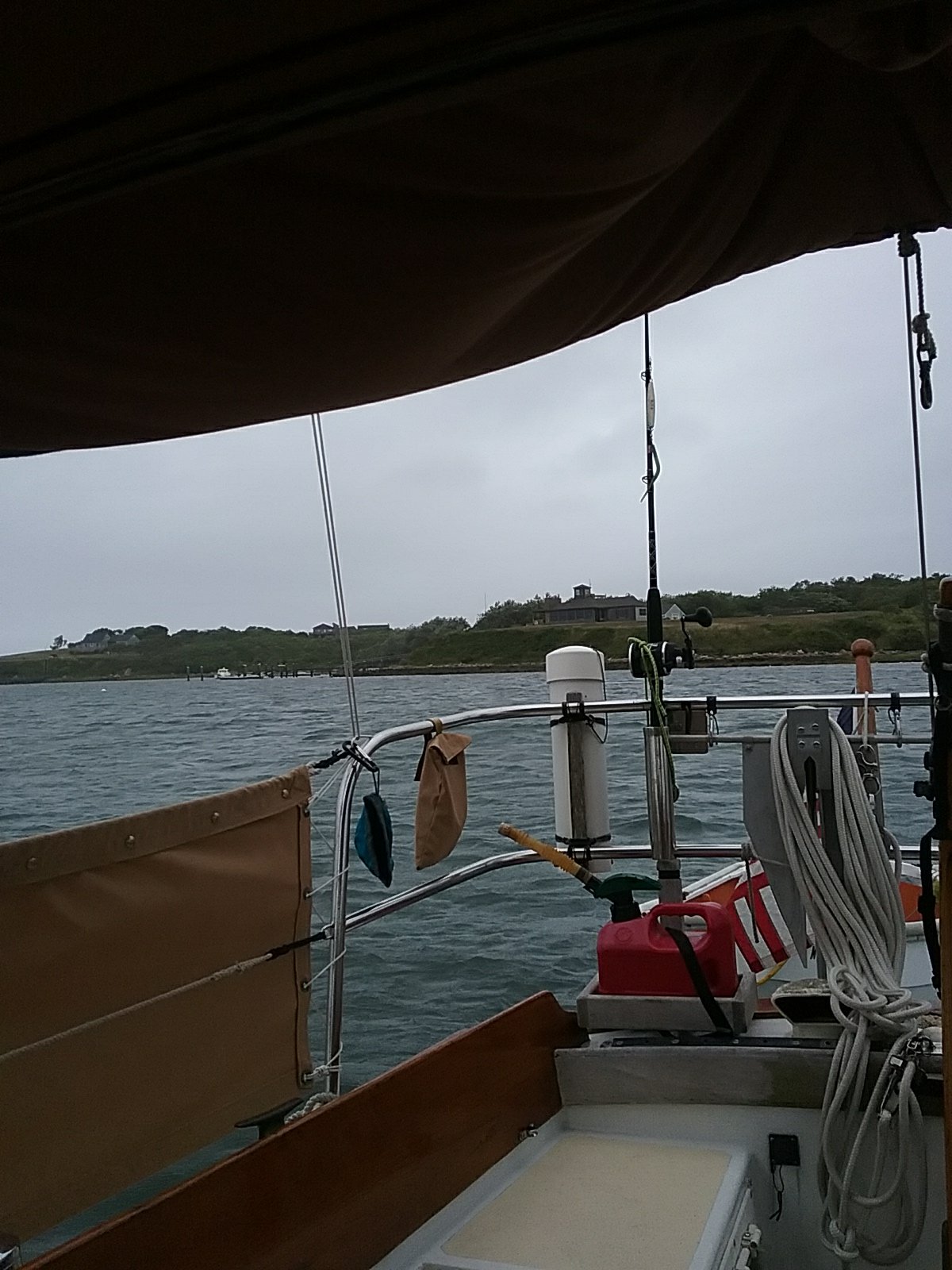
Navigation- (boring technical information)
I enjoy cranking winches and pulling strings much more than researching electronics. My setup is pretty simple and I am no expert on GPS.
The Books of Bob were out every day. 2018 ICW Cruising Guide by Bob423 (Sherer) really helped in the planning. He migrates down the ICW every year and talks about problem areas and his favorite anchorages. The book is layed out in legs which helps to keep things organized. He makes suggestions about navigation software and ways to shut down a house. He cruises with his wife (Ann) and his dog (Hoolie). He points out many good places to land your furry friend. Bob has a big, fast, Beneteau sailboat. He seems very driven to get down to Florida quickly. We average 5 knots or less and explore different spots. We anchored in many more places. This brings me to, Anchorages Along the Intracoastal Waterway by Skipper Bob. He also has several other books on marinas, the Bahamas, the New York canal system, etcetera. The Anchorages book lists lots of different coves and creeks to drop the hook. Very useful.
I’m a big believer in paper charts. It was expensive, but I purchased chart books for the entire East coast of the US. The charts I used were produced by Maptech, NV Charts, and Kettlewell. GPS screens are small. It’s nice to have “big charts” to give you the “big picture”.
We have an older Lowrance GPS chartplotter hardwired into Catalpa. It works. It has a depth sounder built in. The chart chip is old so I don’t always trust the information. I have an Android pad and downloaded a navigation app called Aqua Map Marine. This became so important that I actually purchased a second pad in Florida just in case one died. Aqua Map has constantly updated chart information. It also displays Active Captain information. Active Captain (AC) is a crowd sourced online database of information on marine hazards and anchorages. Since AC is crowd sourced not all the information is accurate. Some of the info is more opinion than fact. Having said that, it’s generally pretty good. My only complaint about using an Android pad or IPad for navigation is that we had over-heating issues on sunny days. I tried to keep them in the shade when necessary. I used Aqua Map for the whole trip. I’ve heard Navionics is also good and is tied in with AC. I plan on trying it sometime. As mentioned earlier, I also used Google Maps to find parks, grocery stores, pharmacies, and fuel. It’s also a very useful tool.
Our electrical needs were small. All of our lights are efficient LEDs. We have one 50watt solar panel to keep the batteries topped up when we’re sitting for long periods. We also have oil lanterns and Luci Lights (solar lanterns). The oil lanterns helped to keep us warm and dry gear out when necessary.
Hot and Cold-
Our Portable Buddy Heater propane heater wasn’t used much but when we needed it, we REALLY needed it. We got hit with some pretty cold weather near Charleston on our journey south. We were stuck in a remote location for a few days and almost ran out of propane before the weather improved.
Lynne and I both have decent foul weather gear. I have two full sets. When the weather got really cold and wet my Grundens fishermen gear was what kept me dry. Since I had two sets of foulies, I could dry out one set while wearing the other. On the other hand, I only had one set of gloves. My hands were often cold and wet until I received a second pair from my mother. In Florida we both switched to really light (hiking) raincoats that we had packed away. We used all of the cold weather gear we brought with us. It all got packed away in Marathon and we were in tee shirts and shorts for the remainder of the voyage.
Sticking with the hot/ cold theme: refrigeration.
Lynne is a great cook and likes to work with fresh food. Our tiny galley seems to be constantly in use. We have an icebox without any kind of mechanical refrigeration. It was a project to get ice. We’ve never had a problem before, but we live in the North where both the air and water are cooler. We went through about 10lbs a day. When the weather heated up and we were running the diesel, we’d burn through almost 20lbs. I’d say refrigeration is important and I’d consider it a priority for the next trip. There are a few different options. Ironically, we ate like kings but we both lost a lot of weight. Perhaps it was from lugging around ice and water.
Shade. Many cruisers have full enclosures to protect them from the weather and sun. We have a dodger which is sort of a windshield with a small roof. I prefer this kind of setup to the full enclosure. We have extra awnings to use in harbor. They aren’t really made for travel. Eventually the sun got so hot that I really needed some shade. We used the awning when possible. Some sort of Bimini (little canvas roof) would be a great addition. Our big straw hats were in use.
I was concerned about showering and keeping clean. It was never really a problem. We have an Advanced Elements Summer Shower. It’s basically a black bag with a shower hose on it. The bag heats up in the sun. We hang it from the boom in the cockpit. We have lee cloths to port and starboard. We put up another privacy curtain on the back rail and shower in the cockpit. If it’s cold out we heat up a kettle and add it to the bag or just have a quick wash down in the head (bathroom). Most marinas have showers. Even if we didn’t stay at the marina we could often pay a small usage fee. Early pandemic we stayed away from public showers. Later we brought bottles of sanitizer and sprayed everything down. We also have a black bugsprayer with a kitchen sprayhead on the hose. This pressurizes the water and is nice for hosing down Ollie. We don’t have a water heater or pressurized water on Catalpa. The sinks have foot pumps. They work well and conserve water. It’s a good idea to pack rebuild kits as the rubber bellows and small valves degrade over time.
Both of our boat handling skills improved. We got better at docking. Docking can be difficult due to river currents and wind. We planned our approaches and waited until the wind was right (calm).
We’ve always anchored a lot and continued to do so on this trip. We’re on a budget and anchoring is free. We made an anchor switch down in Boot Key Harbor. My main hook (35lb Delta) seemed to be having issues grabbing the hard sand and coral. This culminated with a dangerous situation where our anchor dragged in the middle of the night. I decided to switch to a 35lb Rocna Vulcan and am happy with the new hook. We attach it to 50′ of chain along with 250′ of rope. We also have a second, lighter, anchor to help out when needed. We only used both anchors once but were glad we had the extra hook when faced with 45mph winds. We crank up all this stuff with a Muir manual windlass. This is heavy gear for this size boat but we sleep well at night. We actually had the older Delta anchor stored onboard along with a bunch of extra chain and rope too. I probably should have sold it down in Marathon. Hurricane? You never know.
September 3rd- Cuttyhunk Island, MA
Fog with light rain. Will it end?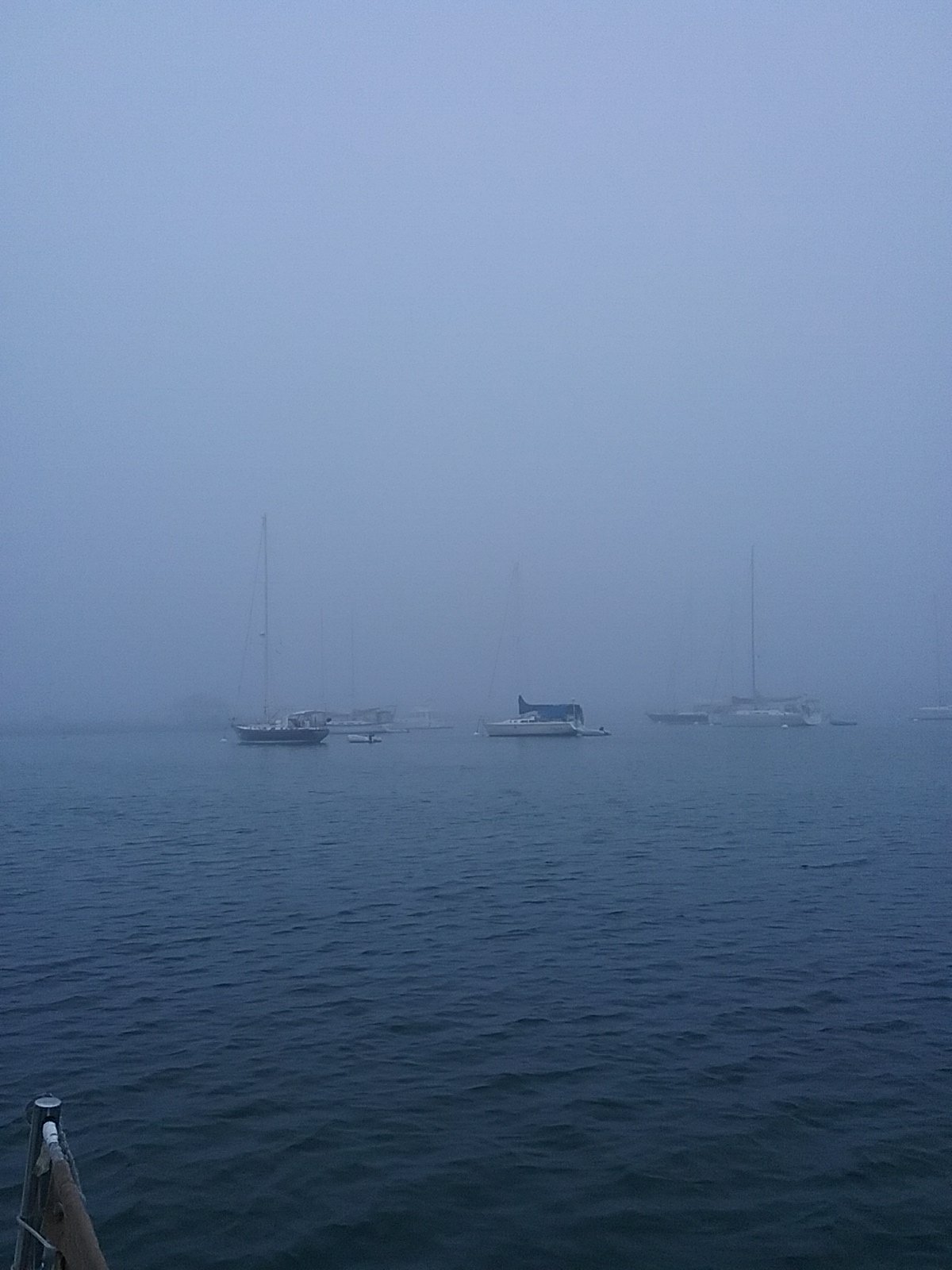
The trip could be divided into pre-pandemic and post. I suppose most important historical events happen that way. Restaurants, brew pubs, and museums were all pre-pandemic. We changed the way we were doing the trip after Covid. Obviously, it was easier to meet up with other cruisers and locals when not worried about becoming mortally ill.
We made friends with many boat gypsies along the way. Lynne is still in contact with a lot of them. It’s a diverse group all united by an odd boat obsession. We recently met up with the captain of SV Loon. We met him down in Vero and were in contact often during our trip. He recently brought his beautiful Loon up here to sell. He is “swallowing the anchor” and going into semi-retirement down in Vero. I think he’ll be back on the water. It was great to hang out for a few days and talk “boats”.
We plan on skipping the ICW this year but are making plans for a future trip. Catalpa is a great boat and I’m attached to her. If she was only 5 or 10 feet longer! She is a little tight for 2 adults and a dog to live on. The 4 foot draft (keel depth) is ideal. There are many shallow spots along the way. We are wading our way into the used boat market and will be making some decisions over the coming months.
I think the rain on Cuttyhunk might be tapering off. Lynne has informed me that she can see a patch of blue sky. Time for some fresh air. Possibly we’ll get some little necks for dinner. There is very little cell phone reception on Cuttyhunk so this post will be going up on our return to Dartmouth.
Some scenes from Cuttyhunk Island.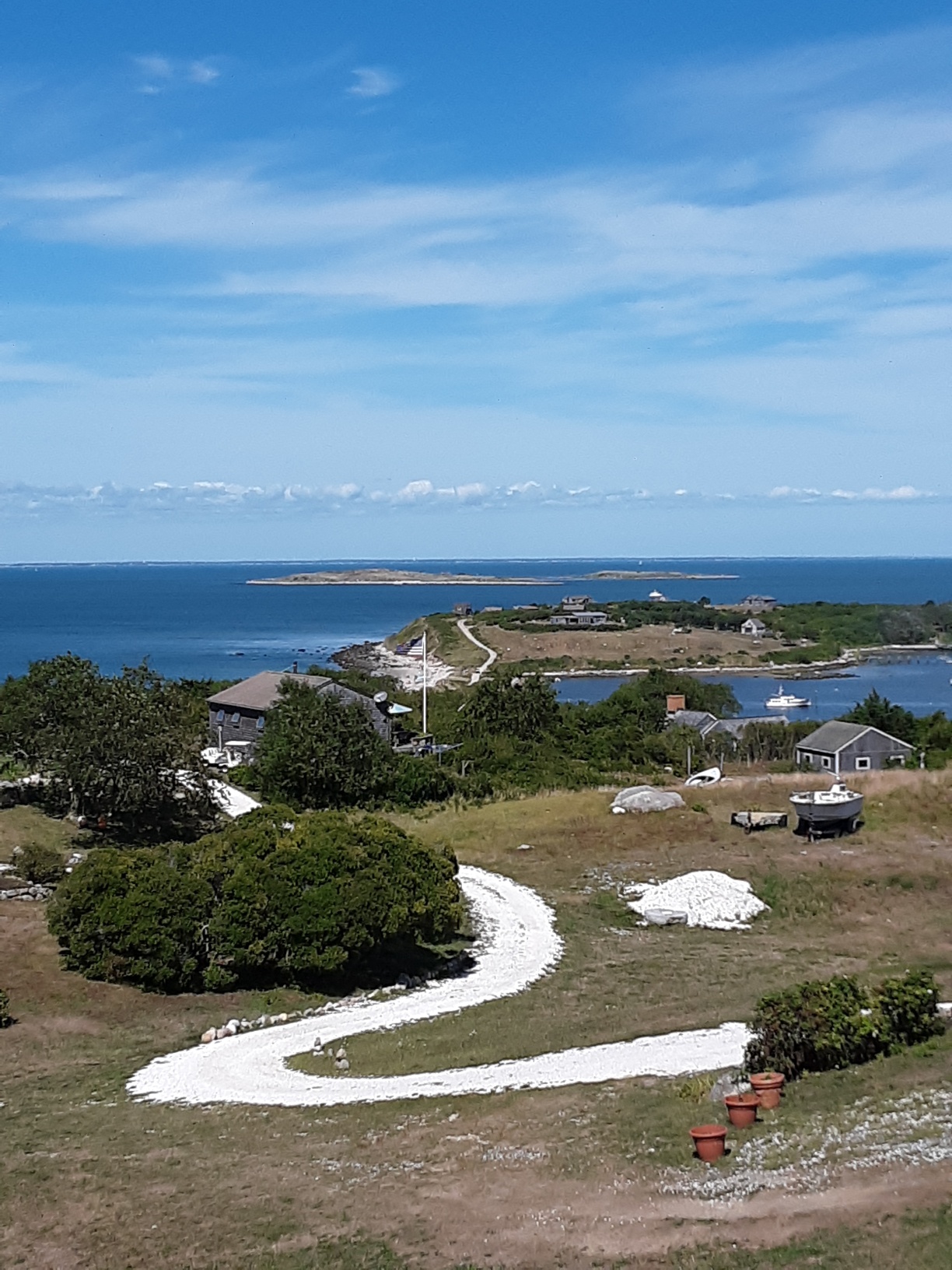
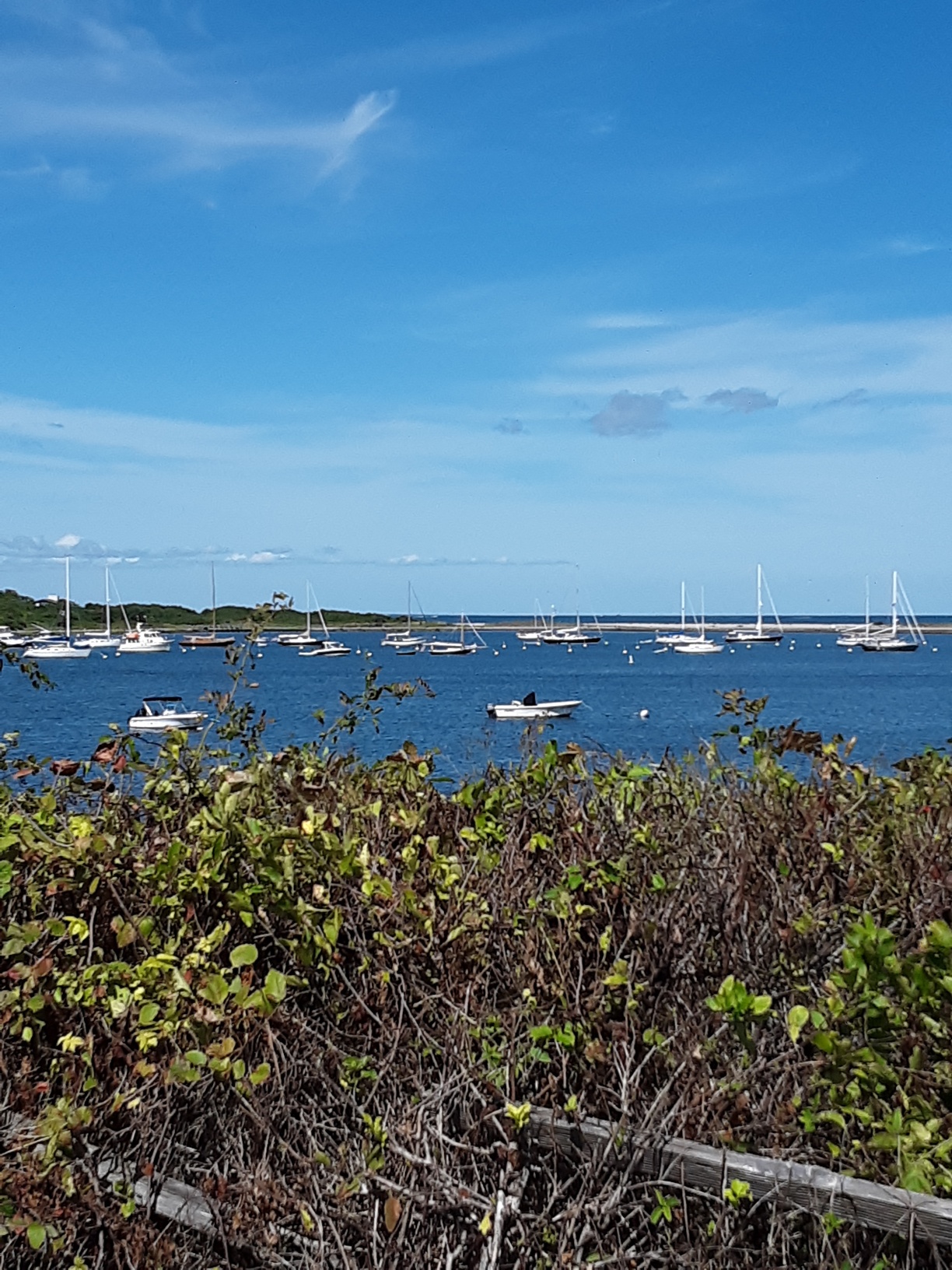
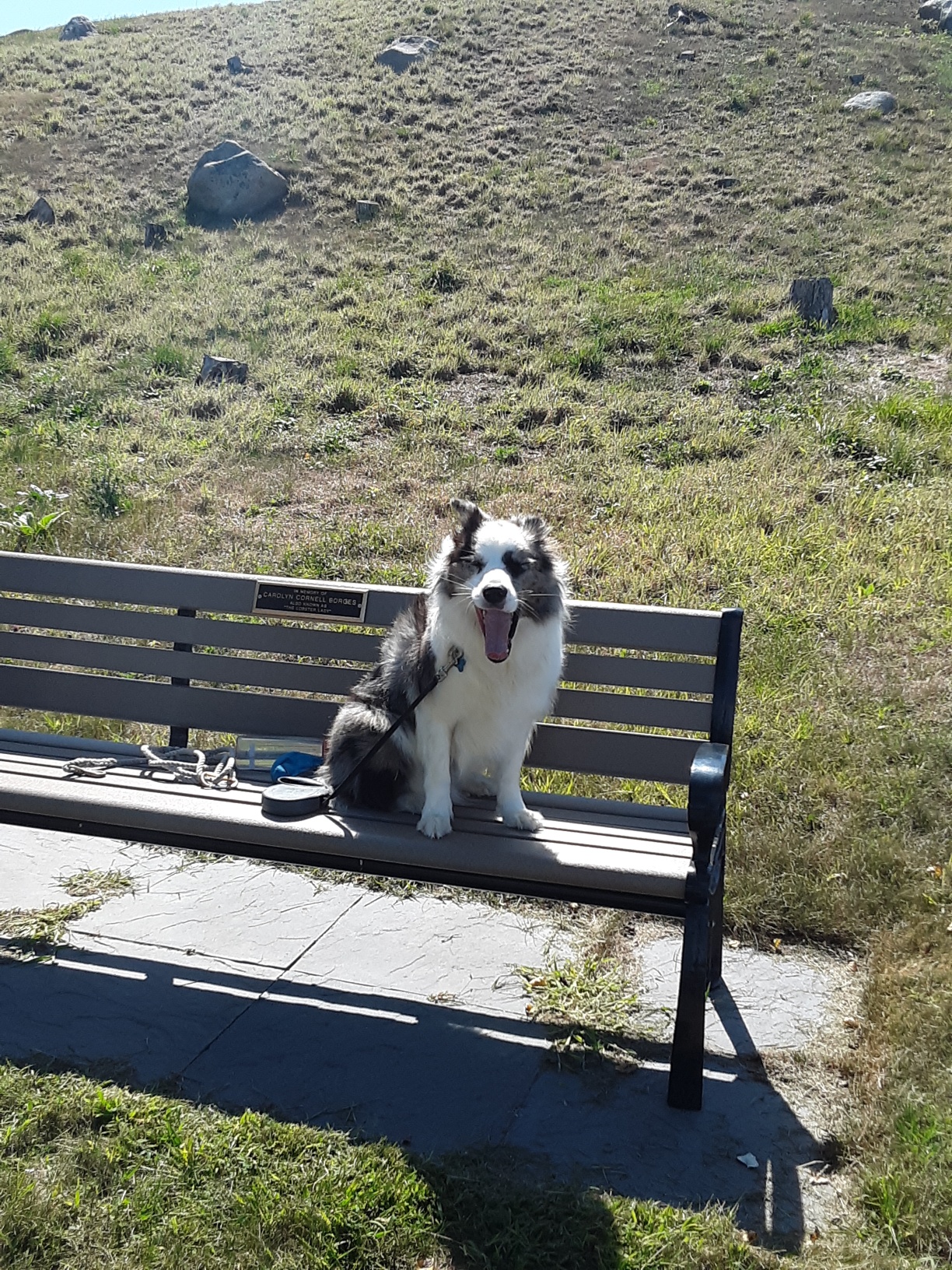
Perhaps he has realized the evolutionary niche of his grey coat.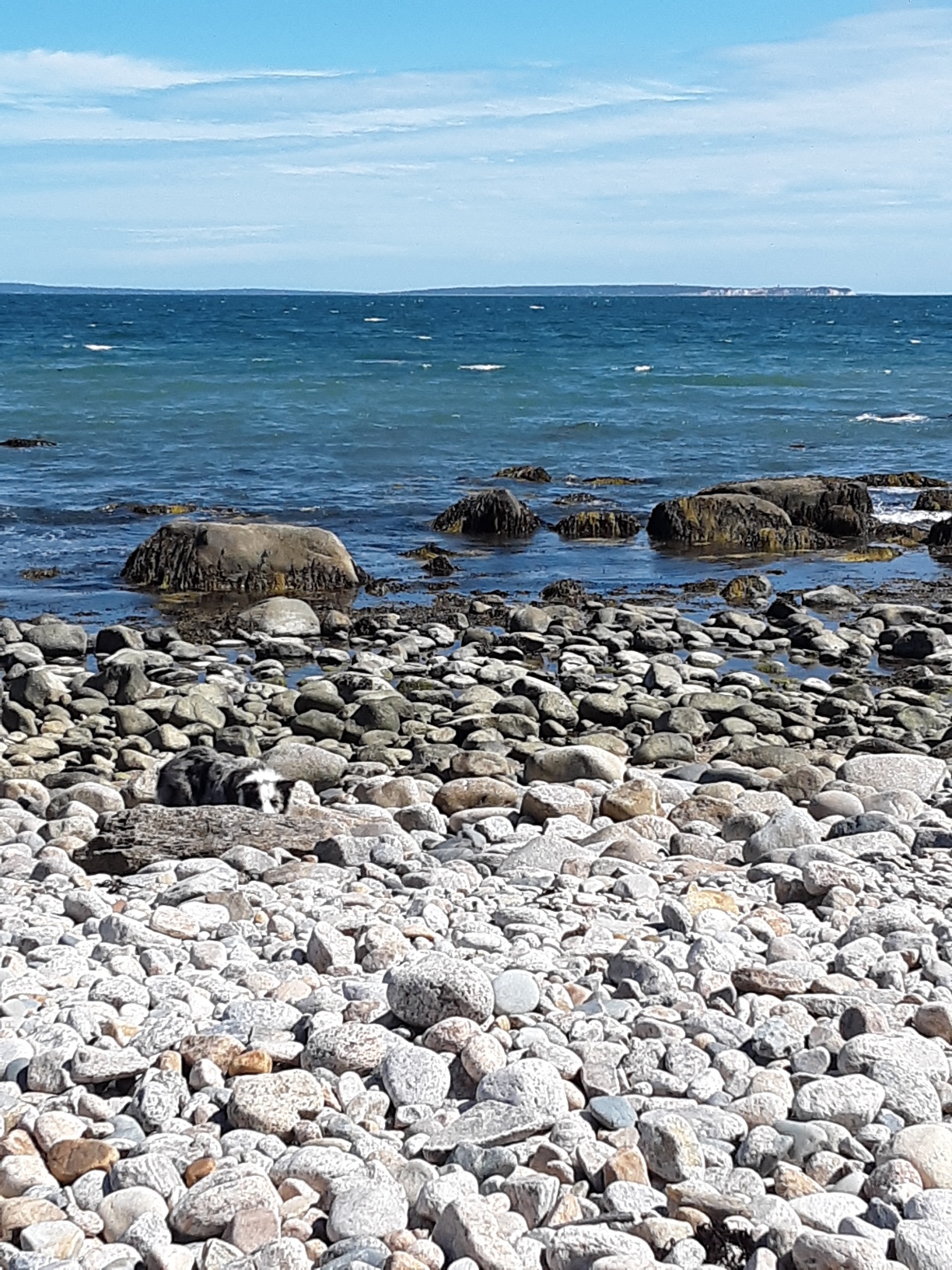
September 4th and 5th- Cuttyhunk Island to Tarpaulin Cove/ Naushon Island, MA
A sunny day.
We were going to return to Dartmouth today but the weather is perfect. Last night we almost had an issue with two large sailboats dragging anchor. Both boats were rafted up and hanging on a single anchor. We woke to shouting and engine noise. Somehow, while still rafted together, they were able to reposition a safe distance away. Such is life on the hook in Cuttyhunk Harbor. There is always some kind of shenanigans going on. Since it’s Labor Day weekend we decided to use some caution and get out. I spoke to the harbor master and he was expecting a full house. Cuttyhunk often slows down in August but with the Covid lockdown, Massachusetts got a late start on summer fun.
After a quick consultation with the Eldridge Tide and Pilot book we found that we’d have a favorable current to bring us to a place we haven’t been in a few years, Tarpaulin Cove.
Brush teeth. Ollie to shore. Get some extra water. Coffee. Up anchor. Attempt to wash some of the mud away. Get out of the entrance before being run down by the MV Cuttyhunk (ferry).
Cuttyhunk is the western extent of the Elisabeth Island chain. It is the only island with a town. Penikese Island is run by the state and has a school for juvenile delinquents (probably not the right term). The school has been shut down for a few years so the island is unoccupied. The rest of the islands are owned by the Forbes family. They’ve been good stewards of the islands and have left them largely untouched. The Forbes family allow landing at a few of the nice beaches (Tarpaulin Cove) and Bull Island. The history of the islands is interesting and worth a read.
We exited Cuttyhunk Harbor passing Penikese to port and Nashwena to starboard. Then onward through Quicks Hole. Quicks has a fast current but it’s working with us today.
Buoy G3 in Quicks Hole. The tide creates the current.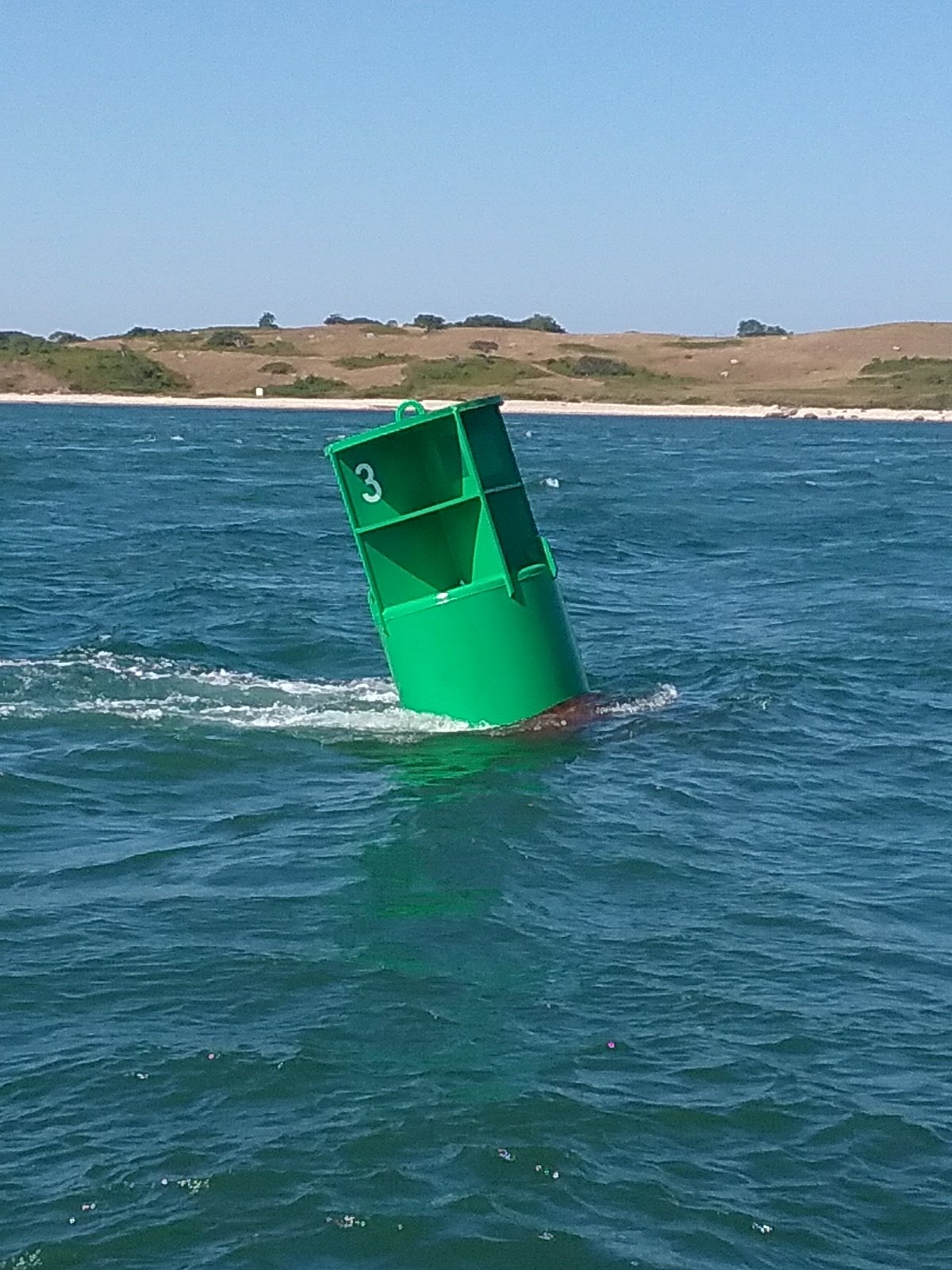
We entered Vineyard Sound with Pasque Island to port and Martha’s Vineyard to starboard. Next on to Naushon Island and our destination, Tarpaulin Cove. I believe we made the trip in under two hours.
Tarpaulin Cove is wide open to Vineyard Sound on one side of it. You have to watch the wind and be prepared to bail-out if necessary. It looks good for the next few days.
We lounged around Catalpa and soaked up some sun. I’m suffering from some sort of mild ailment and figure sun and relaxation might be the treatment. I should stick with eating mild foods, but what fun would that be.
We enjoyed our little necks from the Cuttyhunk Raw Bar yesterday. Today we went over to the beach and attempted to dig for more Quahaugs (clams). None were found but we found some mussels under the rocks. Our take was 11 mussels . Not enough for a meal but they made a fine appetizer.
Lynne and Ollie getting some exercise. 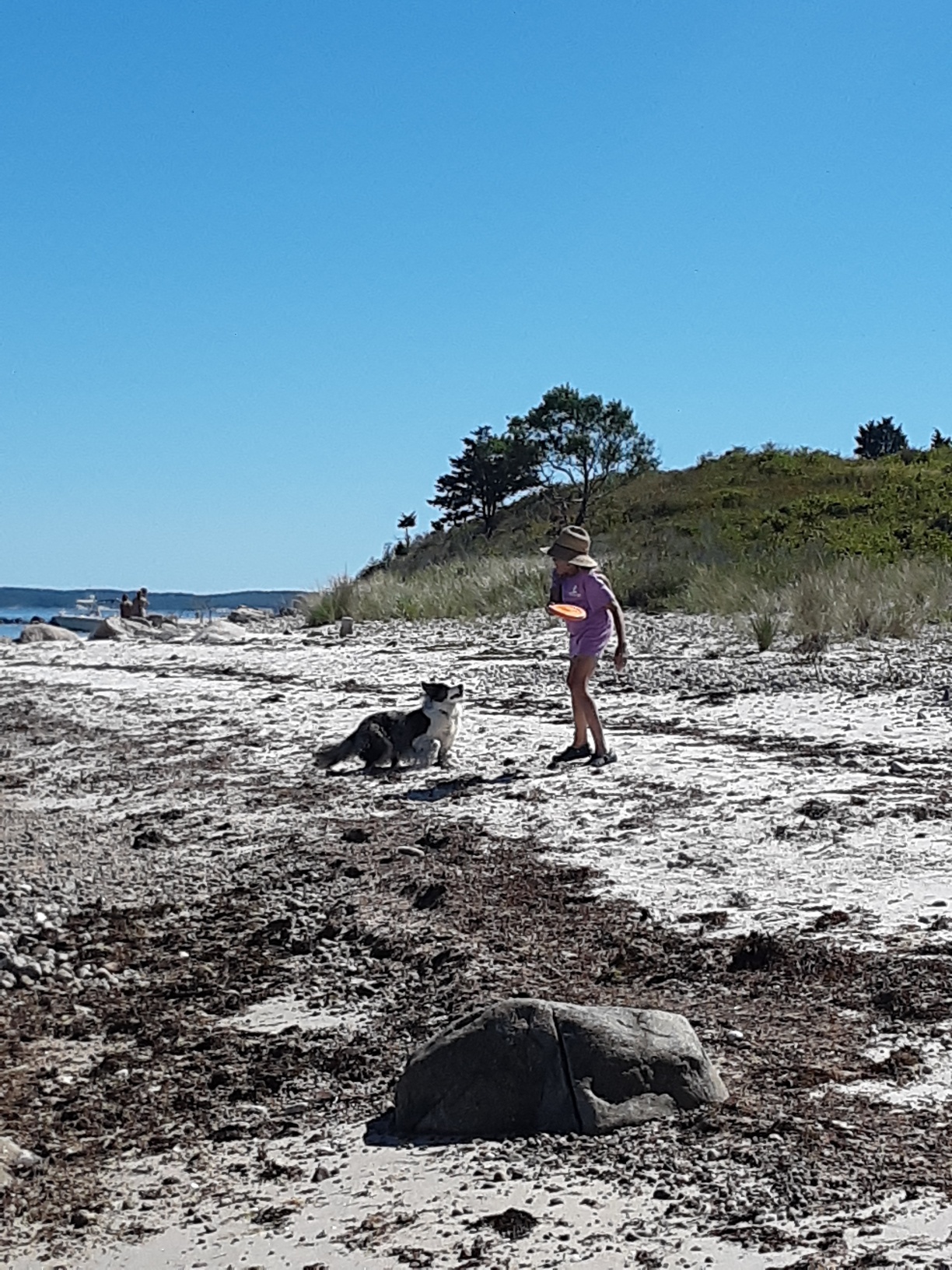
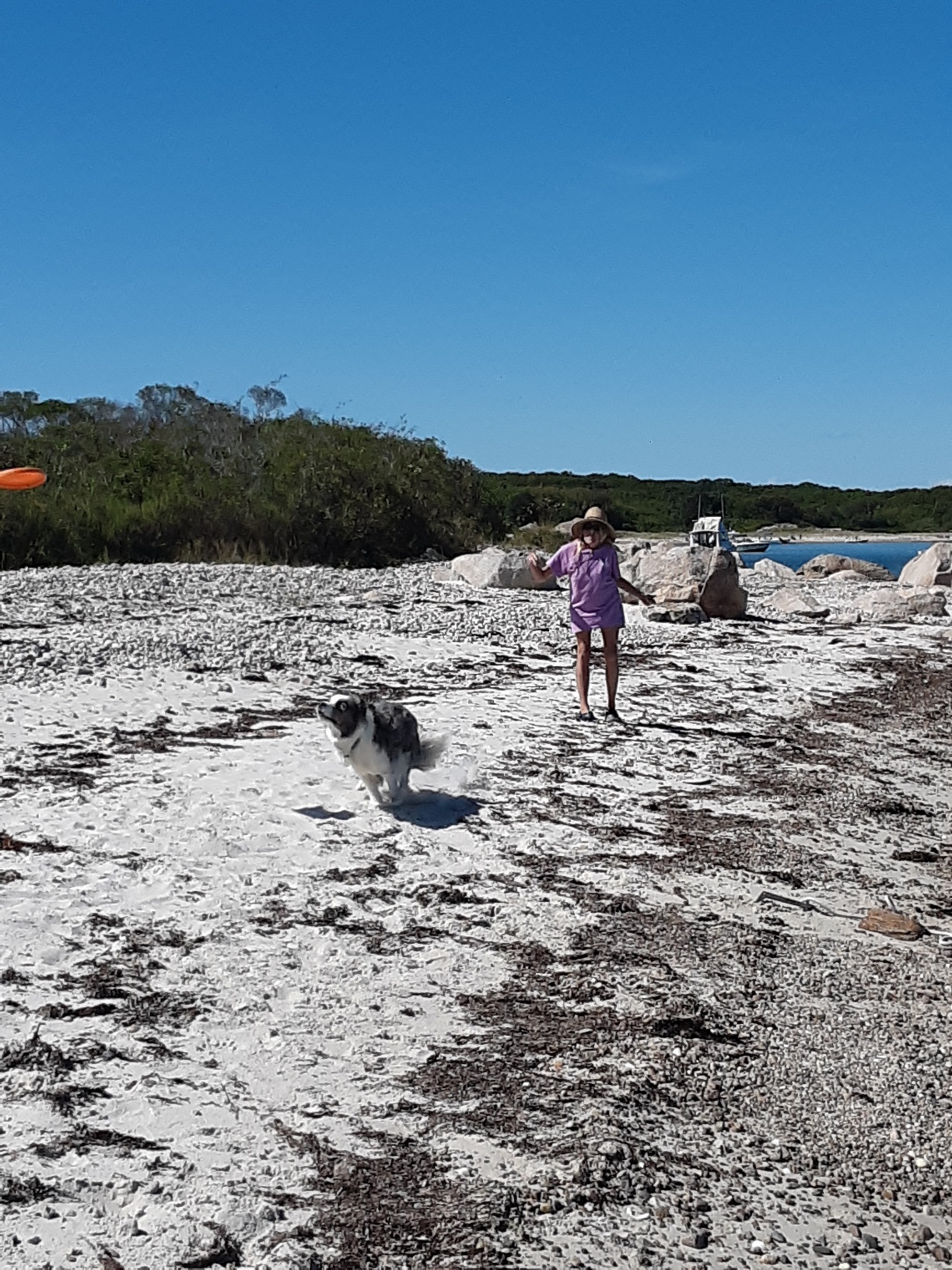
In Howard Mitcham’s Provincetown Seafood Cookbook, his friend Gaspie has a hound dog (Chicki) that can find Quahaugs. Dig Ollie! Dig!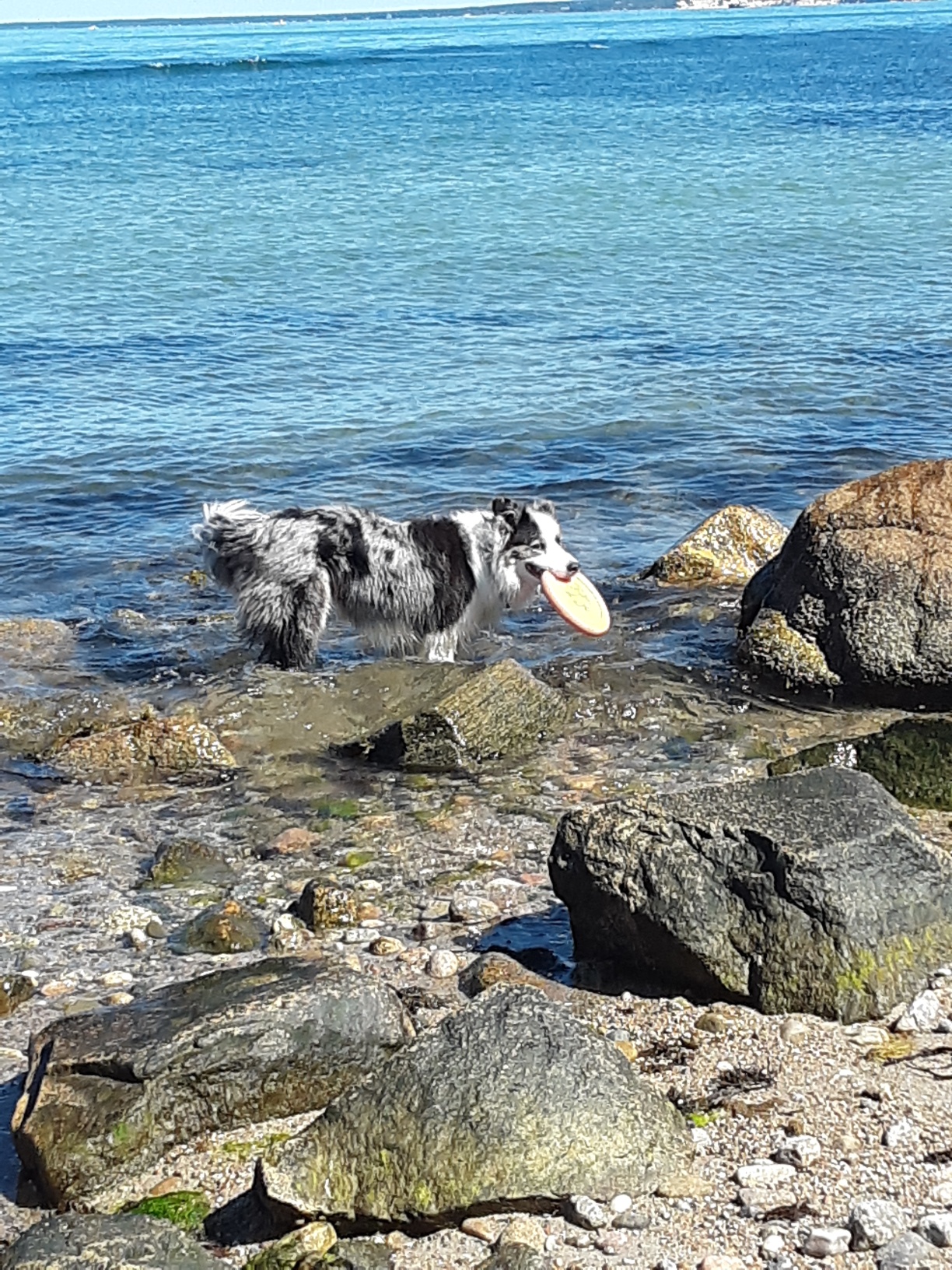
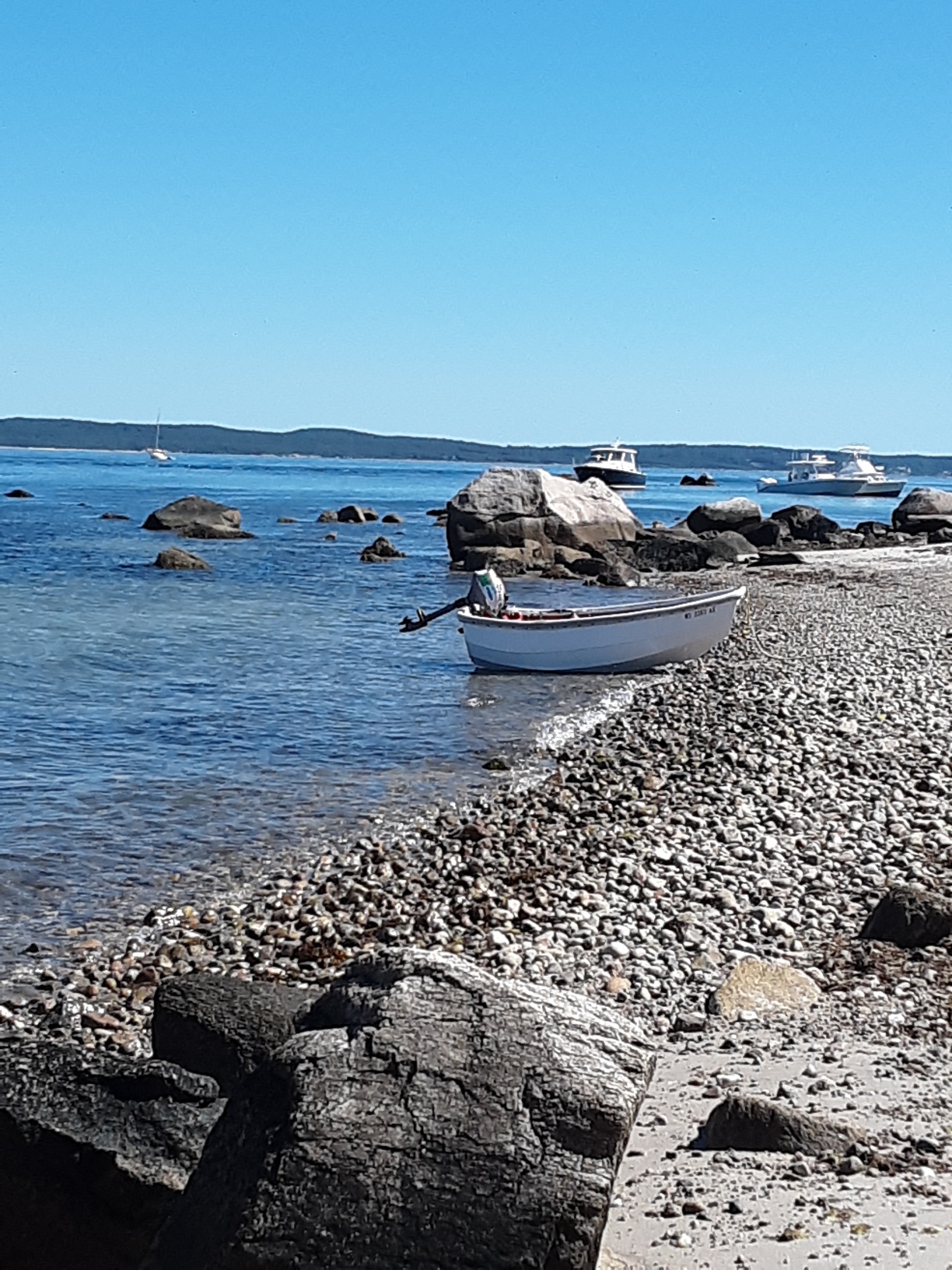
This little vacation is a real “seat of the pants” operation. We only planned for a couple of days at Cuttyhunk. Supplies are running a little low. Ollie has enough food for a few days, then he’s on his own. Today (Saturday the 5th) Lynne has decided she’d like to stay through Labor Day. We’ll sound the tanks to see what the water situation is. We don’t have much ice but then again, we don’t have much food.
Tarpaulin Cove has really filled up. “Filled up” is an exaggeration as it’s big and many more can fit. Everyone is at the beach. There must be a catboat rendezvous as there are 6 or 8 anchored near by. Two of which were the big wooden cats Genevieve and Kathleen. Both the schooners Ishmael and Malabar II sailed in to anchor for the night. John Alden’s famous Malabar schooners were some of the prettiest boats ever built. Ollie hasn’t been here since he was little and is enjoying the sand and sea.
Some scenes from Tarpaulin Cove.
Catboats at anchor with the big (engineless) Kathleen on the right.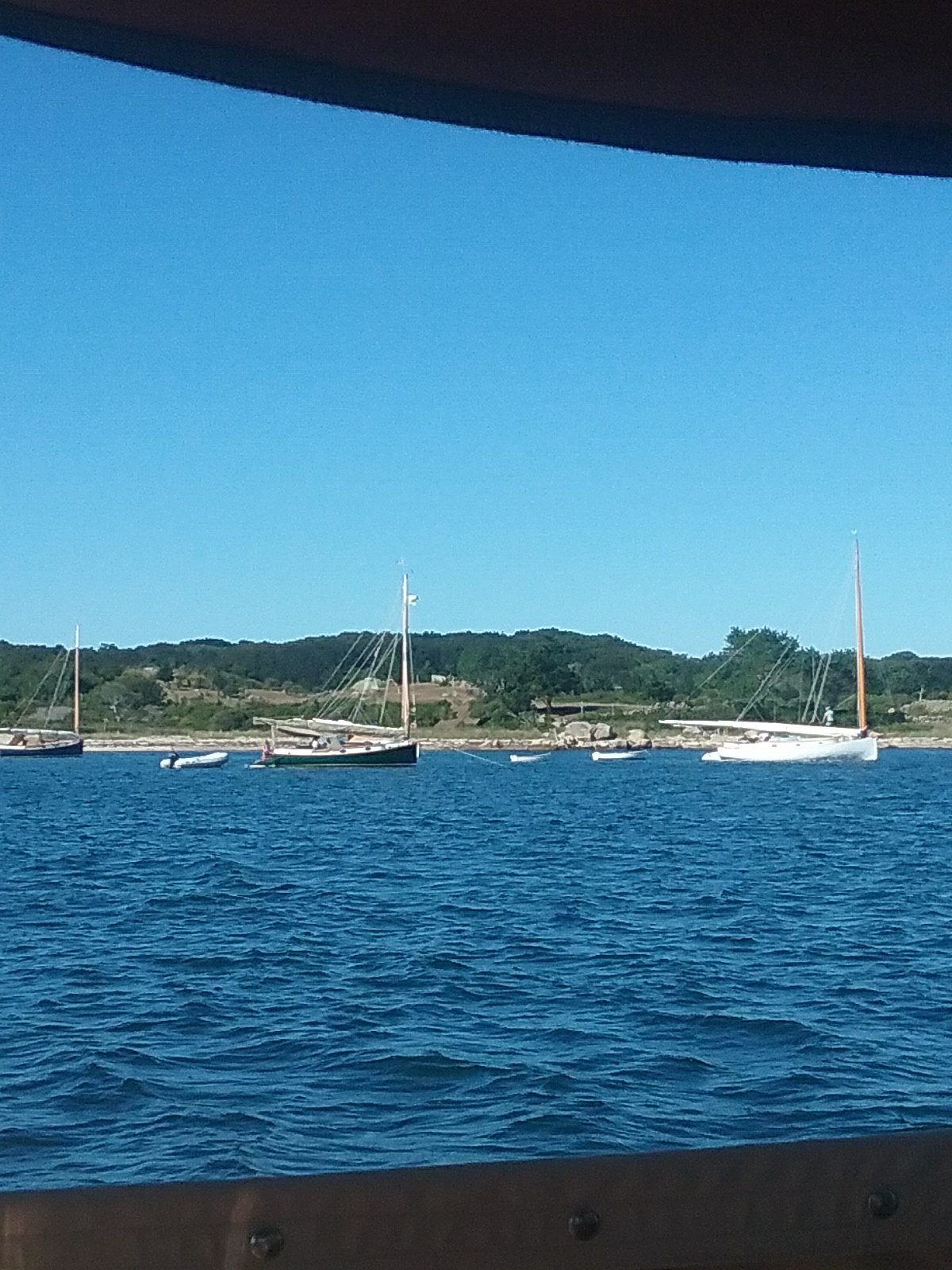
Catboat regatta.
Eldredge McGinnis schooner- Ishmael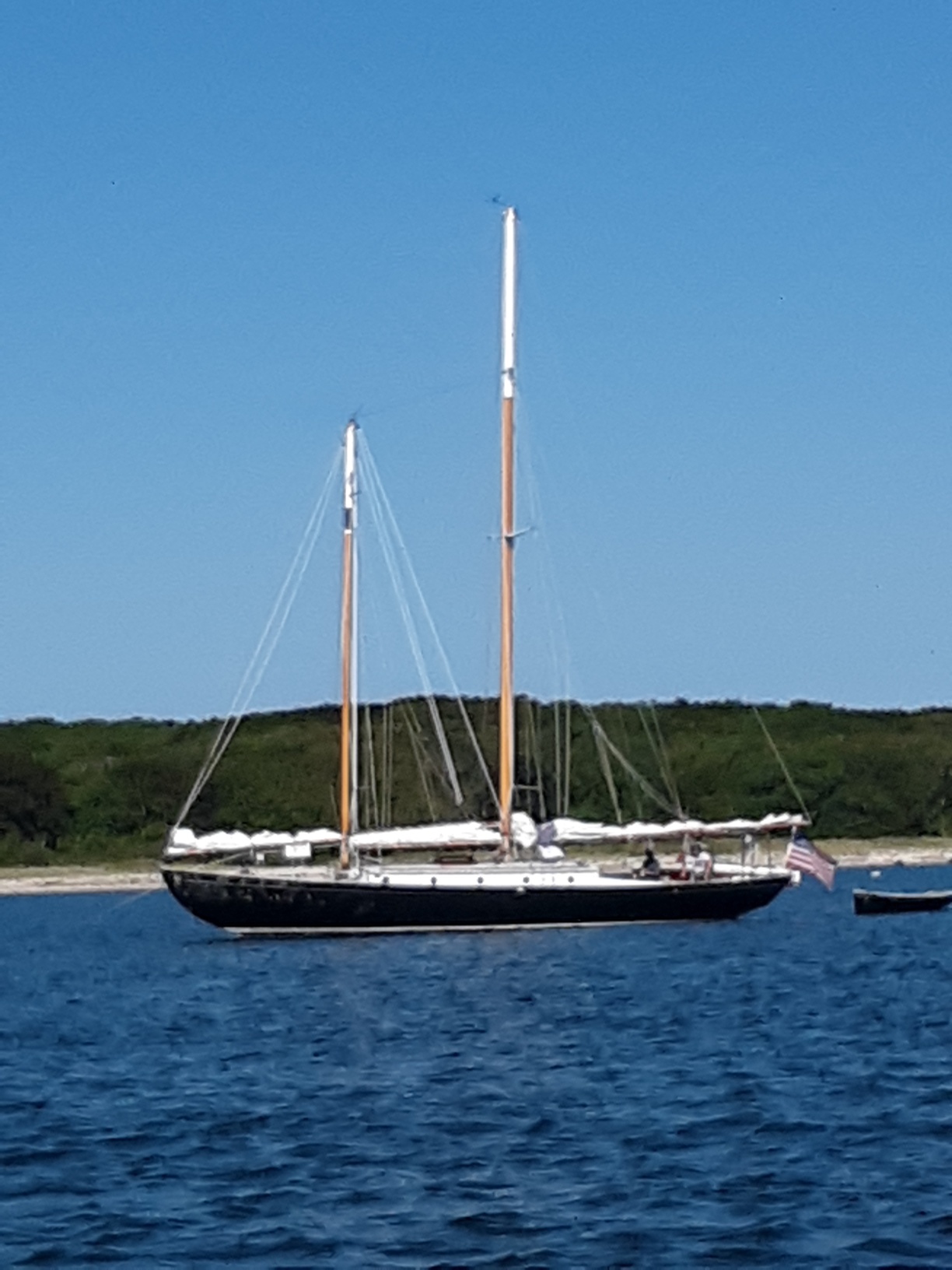
John Alden schooner- Malabar II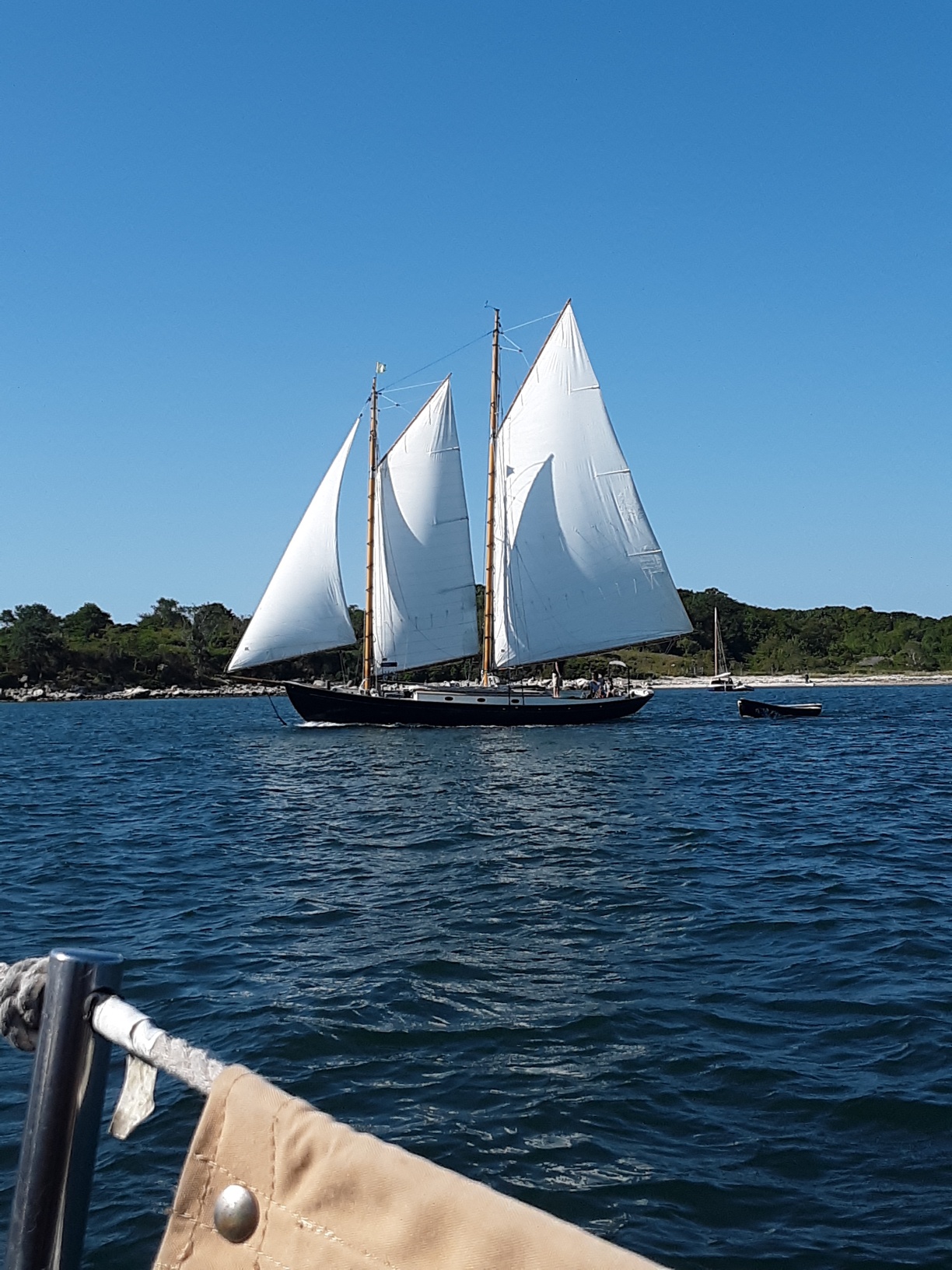
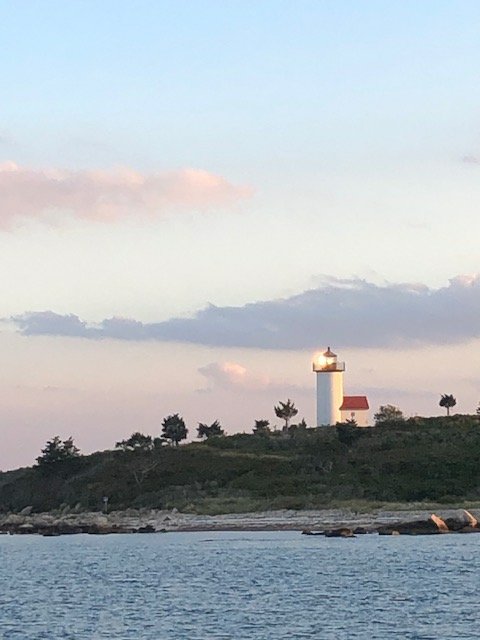
Catalpa anchored in Tarpaulin Cove. 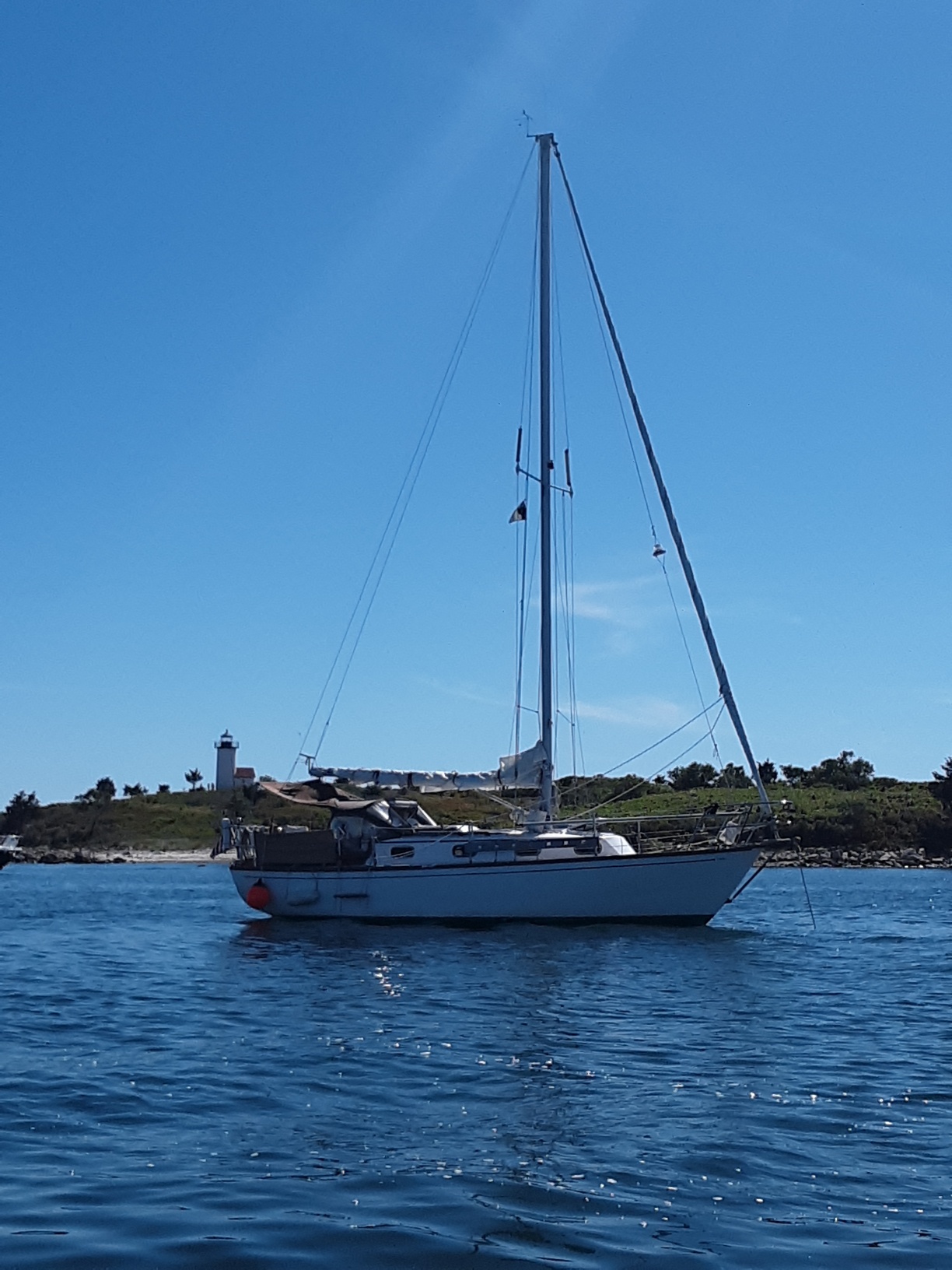
September 6th- Tarpaulin Cove to Padanaram Harbor
We didn’t quite make it to Labor Day. I still wasn’t feeling 100% and the wind seemed like it might be swinging toward the open side of the cove. The schooners left, as did the catboats. Around 1:00pm we decided to do the same.
This turned out to be one of the best sailing days I’ve had in a long while. The wind was out of the southwest and building. We flew down Vineyard Sound to Woods Hole. Woods Hole is a passage between Naushon Island and Cape Cod. It is narrow and confusing to navigate. It also has a big tidal current whose only purpose is to drive your boat onto the many boulders scattered around. It’s a choke point for boat traffic on busy weekends and the Martha’s Vineyard ferries have their main terminal in the town of Woods Hole.
We’ve been through Woods Hole many times but I always motor through. Not today. Dodging fishing skiffs and giant buoys, we sailed our way through. Check that one off the bucket list. I guess I was inspired by watching Malabar II short tacking around Tarpaulin Cove and sailing on and off of his anchor.
On to Buzzards Bay! It’s notorious when our afternoon smokey sou’westers are blowing. One reef in the mains’l (sail reduction) and our genoa rolled up a little. We blasted our way into the chop. Some people hate Buzzards Bay for this wind and short steep waves. We find it exciting. Catalpa cuts through the blue water like a knife. I think I may see the knot meter reach 7 knots but maybe it’s just a hallucination through my salt splattered sun glasses. I race with some big sailboats for a while (they may not know it). Lynne suggests I should join a racing crew to get this kind of thing out of my system.
We tie to our mooring for the night. We’ll head home tomorrow.
Catalpa at her mooring in Padanaram. 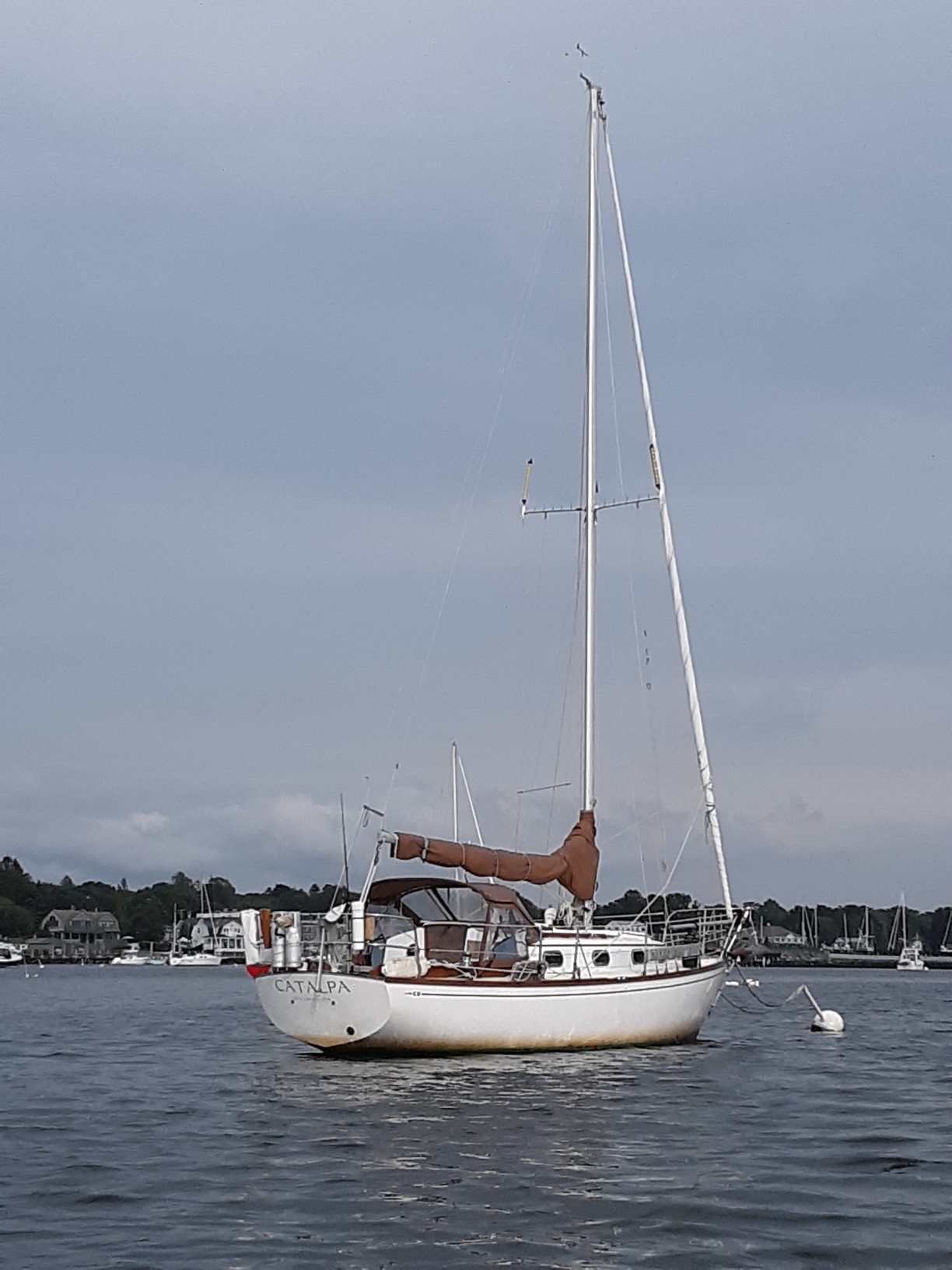
September 7th Labor Day- Padanaram Harbor, Dartmouth MA
Happy Labor Day! Go Unions! Hats off to all the workers that worked through this pandemic!!

Ahoy! Awesome, awesome, awesome! Did I say awesome? LOL.
Write up is so detail oriented that I will be reading it several times to digest it all. Great photos and so much beautiful blue sky. I love the photo of Ollie on the rocks. I almost missed him! The three of you are “hot stuff” and I’m impressed with all you have achieved. Love y’all!
I’m so glad to see another blog post! It sounds like you have settled back into land living nicely. We will miss you this winter but we are definitely heading to New England next summer so hopefully we will share an anchorage then. Kimberly and Jeff, SV Pegu Club
Great to hear from you. It only took me about a month to figure out the WordPress comments feature. Enjoy the trip south. It’s getting chilly up here.